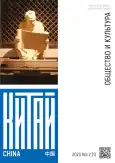Политический кризис в эпоху поздней Мин
- Авторы: Чурсина К.О.1
-
Учреждения:
- Независимый исследователь
- Выпуск: Том 2, № 1 (2023)
- Страницы: 83-91
- Раздел: Оригинальные исследования
- URL: https://bakhtiniada.ru/China_SC/article/view/250048
- DOI: https://doi.org/10.17816/Ch321544
- ID: 250048
Цитировать
Полный текст
Аннотация
Минская империя — одно из величайших государств, существовавших в XIV–XVII вв. Однако в 1644 г. империя пала и трон был захвачен маньчжурами. Возникает вопрос: что стало причиной того, что могучее централизованное государство было разрушено действиями мятежников, а потом и внешним врагом? В данной статье предпринята попытка ответить на этот вопрос. Причины падения рассматриваются автором через призму внутриполитической борьбы с целью выделить главные противоборствующие стороны политического кризиса в эпоху поздней Мин, проанализировать динамику их взаимодействия. Иными словами, перейти от рассмотрения традиционного для имперской историографии сюжета о борьбе верных трону чиновников с коррумпированными евнухами к исследованию исторического процесса борьбы основных политических субъектов в период с ١٥٩٧ по ١٦٤٤ г. Изучение политического процесса рассматриваемого периода на основе анализа и перевода частей источника «Мин ши» («Нормативная история [эпохи] Мин), также в исследовании изучаются приоритеты упоминаний коллективных субъектов исторического процесса в другом памятнике, Мин шилу («Правдивые записи [эпохи] Мин»). В общем и целом, использование этих двух источников позволило решить вопросы, поставленные в исследовании.
Ключевые слова
Полный текст
Открыть статью на сайте журналаОб авторах
Ксения Олеговна Чурсина
Независимый исследователь
Автор, ответственный за переписку.
Email: kseniach1999@mail.ru
независимый исследователь
Россия, СамараСписок литературы
- Симоновская Л.В. Великая крестьянская война в Китае ١٦٢٨–١٦٤٥ гг. М.: Учпедгиз, 1958. 111 с.
- Huang R. 1587, a Year of No Significance: The Ming Dynasty in Decline. New Haven: Yale University Press, 1981. 278 p.
- 吕黄艳。明不亡于流寇 而亡于厂卫。文化学刊。2020。№ 9。页 250–252。 [Лю Хуанянь. Мин погибла не от разбойников, а от сыскной стражи // Культура. 2020. № 9. С. 250–252].
- 王天有。东林党和张居正。学习与思考。1984。№2。页 61–66。 [Ван Тянью. Партия Дунлинь и Чжан Цзюйчжэн // Изучение и анализ. 1984. № 2. С. 61–66].
- Swope K. The Military Collapse of China’s Ming Dynasty, 1618–44. New York: Routledge, 2014. 291 p. P. 209–211.
- Ming shilu: Shen-zong shilu. Chinese Text Project. Доступ по ссылке: https://ctext.org/wiki.pl?if=en&res=964038
- Ming shilu: Guang-zong shilu. Chinese Text Project. Доступ по ссылке: https://ctext.org/wiki.pl?if=en&res=328418
- Ming shilu: Xi-zong shilu. Chinese Text Project. Доступ по ссылке: https://ctext.org/wiki.pl?if=en&res=643474
- Ming shi. Chinese Text Project. Доступ по ссылке: https://ctext.org/wiki.pl?if=en&res=410835
- Деопик Д.В. Опыт количественного анализа древней восточной летописи «Чуньцю» // Математические методы в историко-экономических в историко-культурных исследованиях / отв. ред. И.Д. Ковальченко. М.: Наука, 1977. С. 144–190.
- Башкеев В.В., Ульянов М.Ю., Целуйко М.С. Подходы к исследованию политических процессов в описании древней и средневековой истории Китая и стран Юго-Восточной Азии // Отголосок прошедшего в будущем: Сб. статей. М.: Изд-во ПСТГУ, 2012. С. 41–71.
Дополнительные файлы








